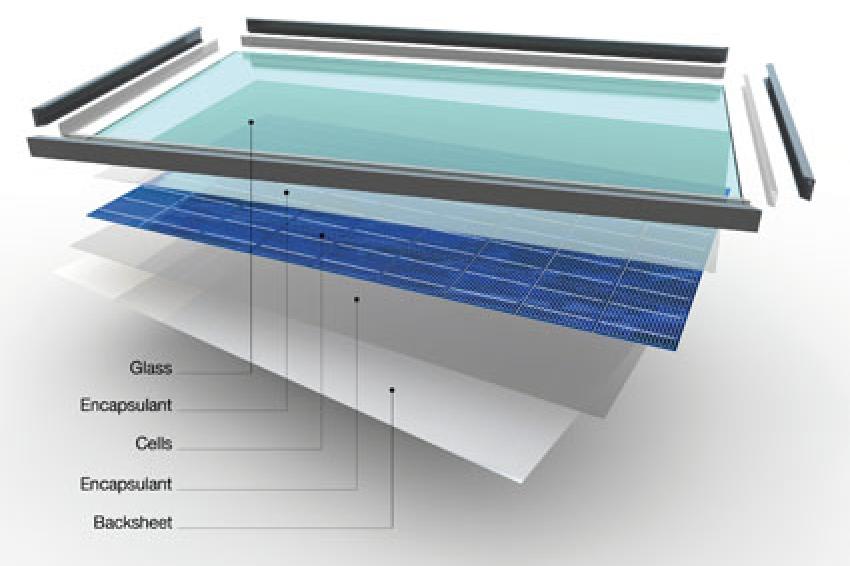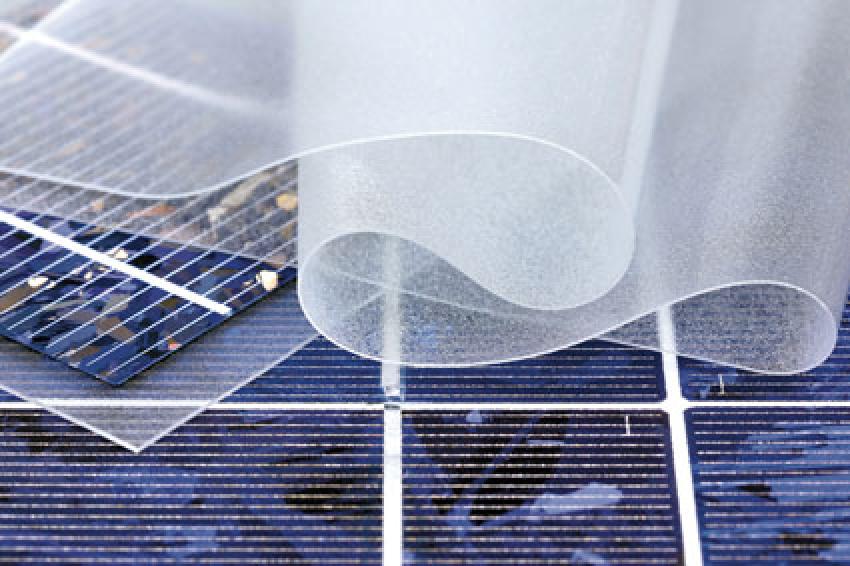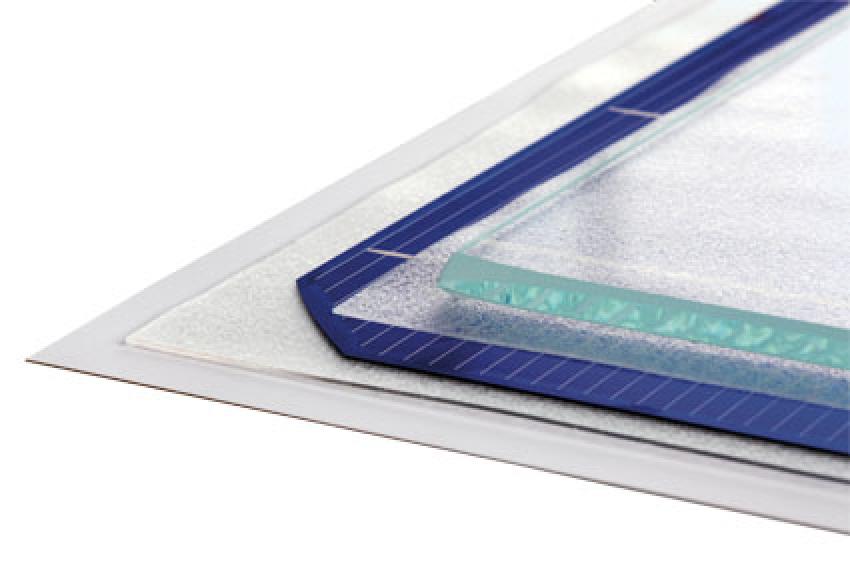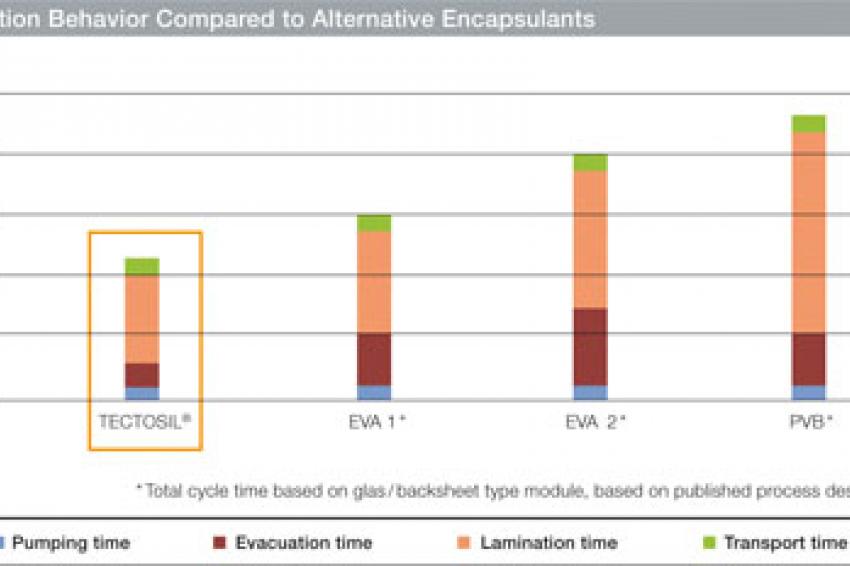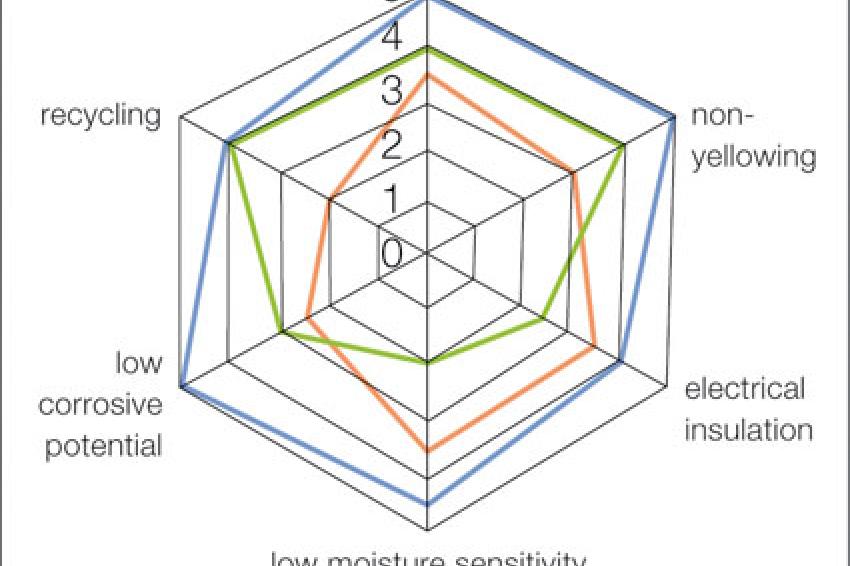Rapid Processing, High Module Quality
Cost-Efficient and Sustainable Lamination of PV Modules
The photovoltaic (PV) industry is looking for ways to boost the cost-efficiency of module production and prolong module service life. An innovative encapsulant can play a key role here: the silicone-based thermoplastic film permits fast lamination, is suitable for any module type, provides sensitive solar cells with lasting protection and improves recycling of solar cells at the end of their life cycle.
The photovoltaic (PV) industry is currently devoting considerable effort to reducing production costs and improving module quality, especially in terms of durability. The fragile solar cells, in particular, must be protected against damage that can arise from mechanical and chemical stresses. In standard modules, for example, hyperpure crystalline silicon solar cells are encapsulated in a suitable material. They are then laminated (Fig. 1) using a glass panel and a backing film - sometimes with a rear glass panel, too.
The encapsulant not only ensures protection against mechanical and chemical influences and electrical insulation. It also bonds the module components into a stable laminate and helps determine module reliability and durability.
Requirements on the Encapsulant
Some of the aging processes that affect modules are directly or indirectly linked to the encapsulants currently in use. Their dielectric and optical properties should not vary during operation. It is also important that the encapsulant optically couples to the front glass panel to minimize reflection losses.
Furthermore, the encapsulant must adhere well to all the laminate components, exhibit sufficient flexibility and be able to compensate for differences in thermal expansion of the individual module components. The encapsulant must be chemically unreactive toward the encapsulated solar cells and conductor circuits throughout a module's service life. It must also prevent moisture and corrosive substances from migrating to the encapsulated components. Additionally, it should be as simple to handle and enable easy and fast processing.
The Search for New Encapsulation Materials
Silicone rubber grades were widely used to pot solar cells. They crosslink to form elastomers which give solar cells extremely good mechanical and chemical protection. But, for technical reasons, it has so far been impossible to use lamination with liquid silicones in series production. Instead, manufacturers turned to vacuum lamination, which involves encapsulation films consisting of suitable polymers. Wacker now has successfully developed a silicone-based elastomer that not only complies with the solar industry's established processing parameters, but also protects solar cells as well as a traditional silicone does. This innovative organo-silicone polymer has been optimized for encapsulation - mainly in regard to the necessary processing temperature, the polymer's molecular weight, the mass fraction of silicone in the polymer. As a result, the optimized elastomer exhibits many properties typical of silicones, but can be processed as a conventional organic thermoplastic and is available as a film called Tectosil (Fig. 2).
Properties of the New Encapsulant
The innovative encapsulation film contains no plasticizers, reinforcing fillers, catalysts or organometallic compounds. It consists almost entirely of the optimized organo-silicone polymer.
The organic polymer segments ensure good adhesion to all the materials in the laminate and crosslink the polymer molecules via hydrogen bonds - solely through physical interactions. This type of crosslinking is reversible: temperature variations can trigger transitions between the elastic and plastic states. Unlike a chemically crosslinked silicone elastomer, the new material can therefore deform when exposed to heat; it has a plastic state above approx. 130°C.
The high silicone content makes the material permanently flexible, soft and highly elastic, even at temperatures down to approx. -100°C. The film clings to the substrate extremely tightly. With its very low modulus of elasticity, the new encapsulant can compensate for the different thermal expansions of the materials used in the laminate without any risk of premature delamination. Thus, Tectosil permits stress-free encapsulation of solar cells and affords excellent mechanical protection (Fig. 3).
Being highly transparent, the film ensures optimum light yield for PV modules. The transmittance of the silicone-based elastomer lies between about 93 % and 94 % in the wavelength range relevant to the PV industry (370 to 1,200 nm). Usually, the comparable transmittance of competitive materials doesn't exceed 91 %.
Containing neither catalysts nor corrosive constituents that might affect other materials chemically, the new polymer is chemically stable and remains chemically unaltered with time: no corrosive substances are released during lamination or module operation. That allows the film to be used for encapsulating solar cells containing films of compound semiconductors (e.g. copper-indium-gallium-diselenide or cadmium telluride), and/or other highly sensitive chemical substances - such as transparent conductive oxides.
Fast and Easy Processing
Because of its thermoplastic properties, the silicone-based polymer can be processed quickly and inexpensively - without curing or other chemical reactions. This is one major advantage over all chemically curing encapsulants. The lamination process thus benefits from short production cycles and a high tolerance to local temperature differences within the laminator. This avoids inhomogeneities within the laminate's polymer layers and results in consistently high quality. Modules produced with the new film have passed the tests required by IEC 61215.
When the new encapsulant is processed in a vacuum laminator, its plastic state only needs to last about 5 minutes. The total lamination cycle varies from laminator to laminator, but averages between about 8 and 12 minutes (Fig. 4). No aggressive gases are released during processing of the innovative film, which reduces the chemical stresses that the membrane and pump oil undergo in the vacuum laminator. This reduces laminator downtimes (see Fig. 4).
Combining the properties typical of silicones with the processability of thermoplastics makes Tectosil an ideal photovoltaic encapsulant. Compared to conventional encapsulants, the new film enjoys considerable benefits for the manufacture and quality of PV modules (Fig. 5).
Besides paving the way for new processes that can be
used to cut module-production costs further in the future,
Tectosil also offers an environmental benefit. Since the new encapsulant returns to its plastic state at very high temperatures (above 130°C), modules can easily be dismantled and recycled at the end of their service life, or even for the purpose of reprocessing production waste.

